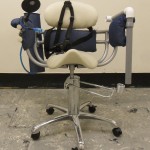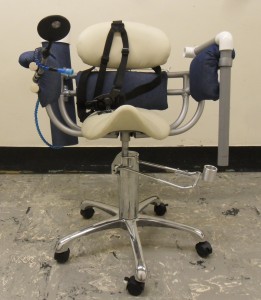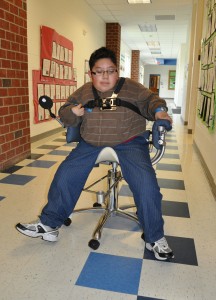Designers: Dong Chen, Tyler Froneberger
Client Coordinator: Kimberly Bailliard, OTR/L
INTRODUCTION
Our client Stephen is a 10-year-old student with scoliosis and Arthrogryposis multiplex congenita (AMC). Stephen has the most common symptoms of both scoliosis and AMC, such as curvature of the limbs and spine, weak muscle contractions, and weak muscle tone. Although many children with AMC have diminished cognitive abilities, Stephen’s cognitive skills are typical for his age. Stephen spends most of his day in a power wheelchair. This limits his opportunities to participate in some Physical Education activities at school. He also has limited mobility at home, as his wheelchair does not fit through the openings in the home and he must scoot on the floor. Therefore, Stephen needs an alternative device that enables him to have independent mobility.
Currently there are a few commercially available gait trainers designed to accommodate individuals with AMC. These gait trainers provide independence, weight support using a harness, and help build leg strength. Unfortunately due to scoliosis, Stephen’s arched limbs and back make it difficult for him to become comfortable in these devices.
We developed a device that enables Stephen to move independently outside of his wheelchair around his home and school. The device provides reliable and safe movement, it is narrow enough to fit in between doorways, and it provides adequate support and comfort for our client. We also included a hydration pack, because Stephen becomes quickly dehydrated throughout the day.
STATEMENT OF IMPACT
Our client, as well as his teacher, aide, and therapists, were all excited about the device. The client nicknamed it the “Sonic Doohickey”! His occupational therapist said: “Great job on the device guys! This device will allow the client to get around his home and will be a great improvement from previous devices. Most importantly, it will help him strengthen his legs each day.”
TECHNICAL DESCRIPTION
Our device design consists of three main components: the saddle-seat chair, the five-wheel base, and the upper body support system, as shown in Figure 1. The client can transfer from his wheelchair to our device with assistance from his aide or therapist. He then adjusts the chair height using a pumping action. Once an optimal height is obtained, the client can use his legs to propel himself laterally in any direction. He is most efficient if he propels himself backwards, so we included a bicycle mirror as a “rear view mirror”. The base provides 360-degree motion and the castor wheels lock during transfers in and out of the chair.
The main body of the device includes the saddle-seat and backrest. This is from a commercially available dentist chair, and the overall size of the seat is 14 inches wide and 18 inches long. A key feature is the arched design of the seat, so the client can comfortably place his legs around the arch when sitting. This allows his legs to reach the ground as if standing, but without the strain on his back.
Because of our client’s poor upper body strength, we included a commercial harness and designed a custom armrest frame to provide him with more support. The frame is 25” wide by 16” deep, which is narrow enough to fit through doorways in the client’s home and is wide enough to allow him to comfortably sit in the chair. The frame is composed of 1” inch steel piping and it is welded together at the armrests, the base of the chair, and to the back of chair frame. Using 1” inch strap fittings, the piping is attached to upholstered armrests composed of a wood backing, memory foam, and they are covered by denim fabric for a nice look and feel.
The dentist chair rests on commercial barbershop chair base. The base includes a pumping mechanism so that the client can adjust the chair height. However this pumping mechanism is located near the bottom of the base, which is too low for our client to safely reach. Therefore, we included a pumping bar, made of PVC tubing. It is stored in a 1” radius slot that is attached to the handlebars. When the client wants to change the height his chair, he removes the pumping bar from the storing location and places it in a 1” diameter slot on the pumping mechanism. He can raise the chair height by repeatedly pumping it forward, and lower the height by pushing and holding it in the forward position.
The base includes 5 castor wheels and the diameter is 24”, which provides stability and prevents the user from tipping the chair.
The device includes several other features: a mirror to provide a rear view for when the client is moving backwards; a basket used to transport his books or other materials; and a hydration pack because the client easily gets dehydrated.
The total cost of the device is $380.




University Operator: (919) 962-2211 | © 2024 The University of North Carolina at Chapel Hill |